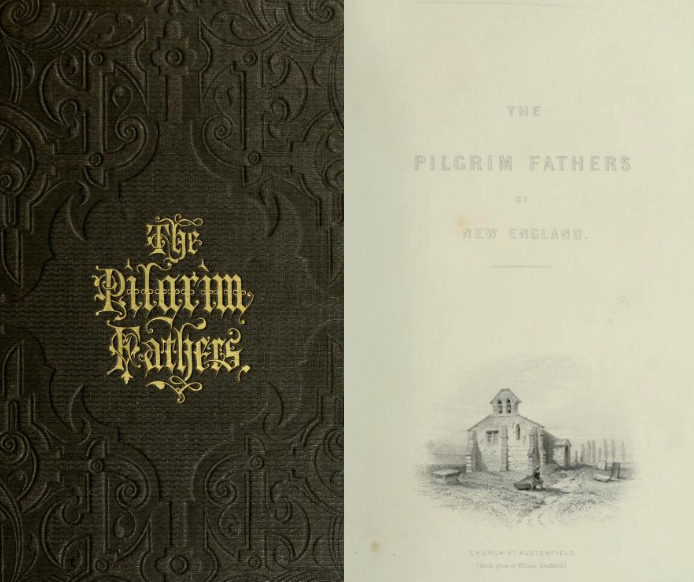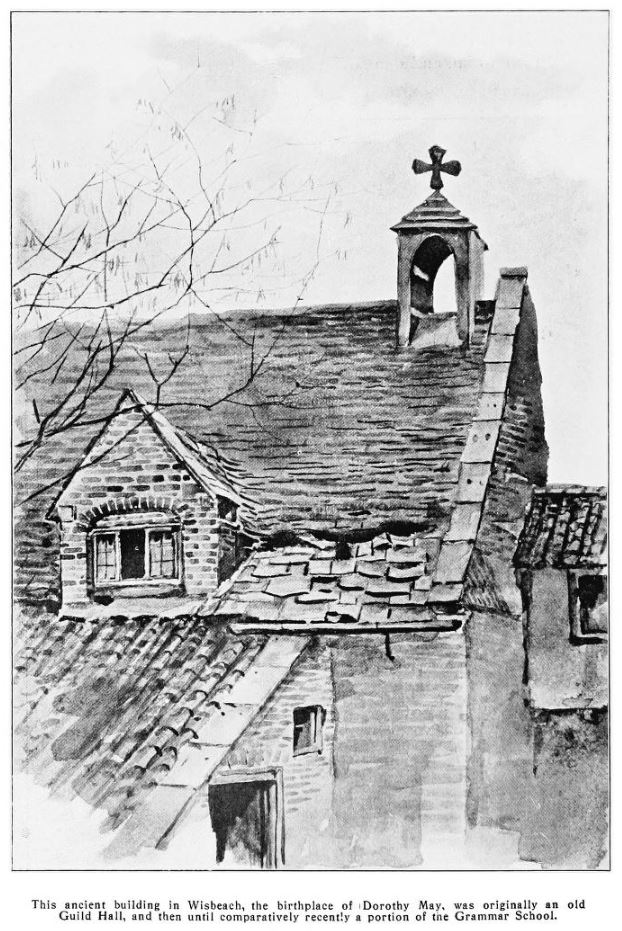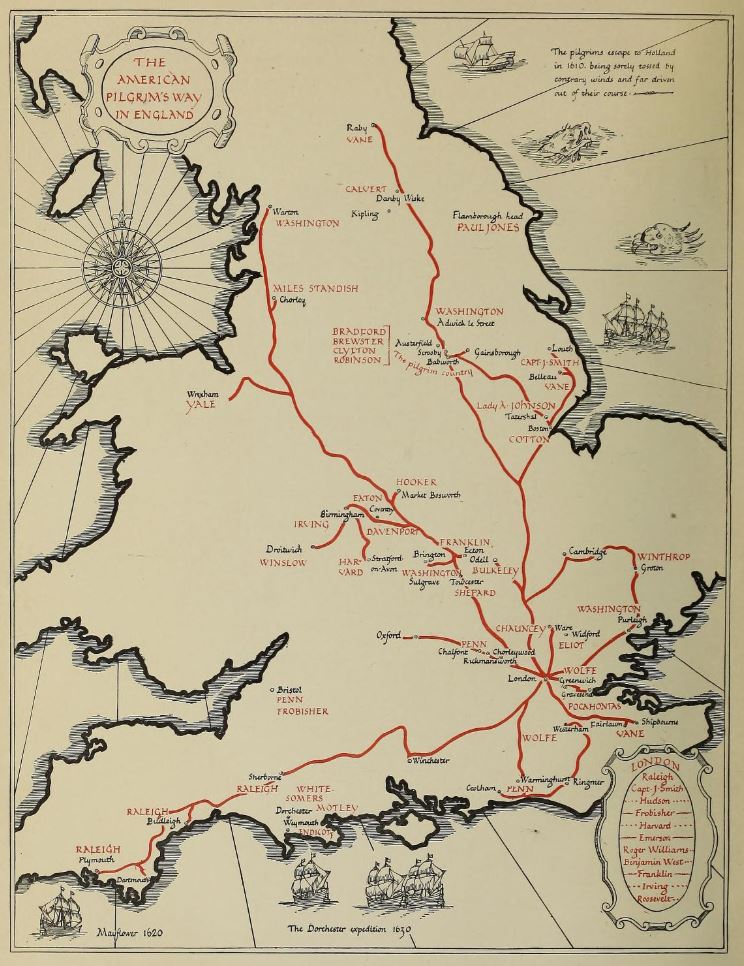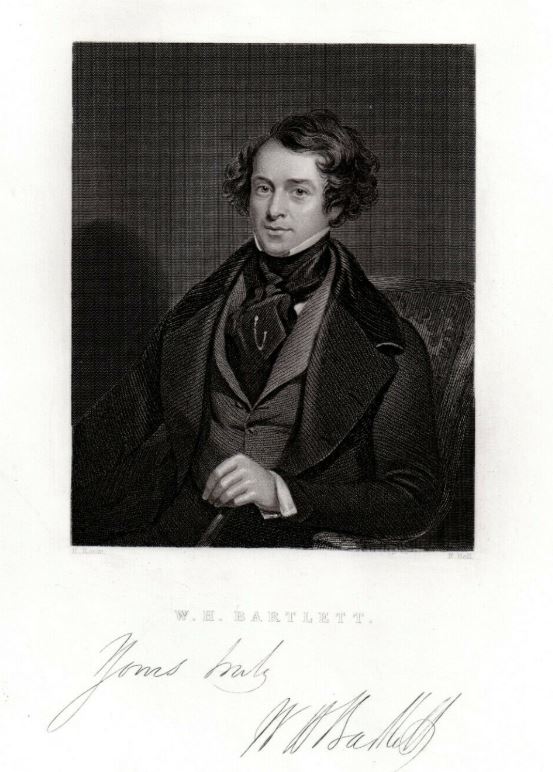The Victorian period witnessed a huge growth in travel literature and tourist guidebooks. The reading public were hungry for material on travel in Britain and further abroad with the growth of the middle classes affording more time and money to be spent on travel. During the 1830s William Henry Bartlett became one of the most popular and prolific topographic illustrators and travel writers of tourist sites both at home and abroad. Bartlett traveled throughout the Europe, the Middle East, and America in pursuit of what he termed the ‘lively impressions of actual sights’ producing hundreds of engravings of ancient architecture, monuments and natural landscapes.[1] Works such as Caledonia Illustrated (1838), American Scenery (1840) and The Nile Boat Or, Glimpses of the Land of Egypt (1849) brought Bartlett considerable fame and attention in Britain and gained him an international audience.
In 1854 Bartlett combined his interest in domestic and international travel in The Pilgrim Fathers, or, The Founders of New England in the Reign of James the First. Tragically, this was the last work Bartlett published. Bartlett died suddenly on 13 September 1854 on board the French steamer Egyptus, on his way home from sketching ecclesiastical architecture in Asia Minor. Despite his untimely death, Bartlett played a vital role in establishing a Mayflower tourist trail in Britain. As he notes in the preface, the lives and locations associated with the Pilgrim Fathers are
almost unknown in England; and it has therefore occurred to the writer of this volume that it might not be altogether uninteresting to compress the scattered particulars of the tale into a continuous narrative, and to give it additional clearness by illustrations of the different localities connected with it.[2]
The Pilgrim Fathers provides engravings and prose descriptions of the villages, churches, and family homes of several prominent separatists. In the English Midlands Bartlett establishes Scrooby, Austerfield, and Boston as important sites on the map of Mayflower locations. In the south, Southampton, Plymouth, and Dartmouth Harbour are visited. Over the coming years all these sites would become recognised as crucial points of interest for Mayflower tourists.

Cover and Frontispiece for Bartlett’s The Pilgrim Fathers, or, The founders of New England in the Reign of James the First – Public Domain
In 1899 the notable nonconformist minister and pacifist Alexander Mackennal published his own tourist guide, entitled Homes and Haunts of the Pilgrim Fathers, alongside 34 illustrations by watercolourist Charles Whymper. Like Bartlett, the work visits Gainsborough, Scrooby, Austerfield, and Boston, before travelling to Leiden and Delfshaven in Holland. However, Mackennal also travels to places that do not feature in Bartlett’s text, including Corpus Christi College at the University of Cambridge (assumed to be where John Robinson was educated) and Wisbech, Cambridgeshire, home of Dorothy May (wife of William Bradford). Mackennal provides a brief account of each location illustrated by Whymper. These contain some rather conjectural accounts of the lives that the separatists may have lived in the early seventeenth century. For instance, Mackennal speculates regarding buildings familiar to Dorothy May:
[She] must have been familiar with the old inn Horn and Pheasant, for that dates back to 1475; and we show its old metal sign, which may still be seen on one of the gabled ends forming an archway into the stable-yard. To-day the inn is known as the Rose and Crown, and is interesting as having has a continuous history as house of entertainment for over four hundred years. Then the old block of half-time buildings shown in another of our pictures most certainly have often been seen by her, and doubtless they have not been considerably alerted since her days. [3]
Phrases such has ‘perhaps she came here […] perhaps she did not’ are common in Homes and Haunts of the Pilgrim Fathers as they are in much Mayflower history and literature. J. R. Harris’ highly speculative work on the ‘Mayflower Barn’ in Buckinghamshire is perhaps the most visible example of the imaginative element common to Mayflower historical writing. The Brownist separatists were not regarded as significant historical actors until centuries after their death. Many of the details of their lives were scantly recorded if at all. It is the historical culture that surrounds the ‘Pilgrim Fathers’ that has brought these people to public prominence – and no small amount of imagination and speculation was used to do so. In establishing a tourist industry around these long-dead emigrants travel writers such and Bartlett and Mackennal played an important role in popularizing this history.

Image from Homes and Haunts of the Pilgrim Fathers showing an old building from Wisbech, Cambridgeshire, home of Dorothy May – Public Domain
Mackennal’s guide had an important afterlife. To coincide with the 300-year anniversary of the sailing of the Mayflower, a Welsh Congregationalist minister and hymn writer, Howell Elvert Lewis, revised and significantly updated Homes and Haunts of the Pilgrim Fathers. Alongside Whymper’s original illustrations are new photographs of Mayflower tourist sites from around Britain and a significantly expanded narrative with additions by Lewis. This text was printed and sold in far greater numbers than the original 1899 work, showing the developing interest in (and market for) Mayflower tourist guides in the run up to the 1920 tercentenary.
Another significant document in the growth of Mayflower tourist literature in Britain is Marcus Bourne Huish’s The American Pilgrim’s Way in England (1907). Huish was a barrister, writer and director of the Fine Arts Society with links to the Pre-Raphaelite movement. Following in the footsteps of Bartlett, Huish’s writing provides descriptions of Mayflower tourist sites across England. The star of the show, however, are the sumptuous watercolour illustrations by Mary Chettle. Indeed, the origin of the text was the paintings produced by Chettle for American tourists visiting the Midlands; this is briefly discussed by Huish in the preface:
It was the pilgrimages made by so many Americans to places in the vicinity of the Midland village in which Miss Chettle resides that led her to commence the pleasurable task of painting the water-colours whose reproductions illustrate this volume – and undertaking which, when I commenced to collaborate with her, enlarged its borders so considerably that it has been a matter or great difficulty to fix its limit. [4]
The work can therefore be understood as part of the market for memorabilia produced for American tourists visiting England. Moreover, the work shows the growth of Mayflower tourism since Bartlett’s work in the 1850s.

The map frontispiece to The American Pilgrim’s Way in England, design by Mary Chettle (1907) – Public Domain
A beautifully illustrated map adorns the title page, showing the location of Mayflower sites around the country. The map suggests that the text could be read as a travel guide to accompany a tour of England beginning in Plymouth. However, Huish notes in the preface how this design ultimately proved impracticable:
Miss Chettle’s first idea was to link the various localities together with a chain such as is indicated by the title and the map facing the title-page, and to plan a route by which the whole pilgrimage could be accomplished. In these days of rapid transit by motor, this can and doubtless may be accomplished, but in compiling the letter press, I found it to be an impossibility to write it in that form […].[5]
Instead, The American Pilgrim’s Way in England functions as a rough guide to tourist locations relating to the Mayflower across England. Its watercolour illustrations offer a romanticised, bucolic evocation of the English countryside. Huish’s prose likewise takes artistic license in imagining places where individuals such as Miles Standish may have visited in their lifetimes.
Today, our own map helps to bring the Mayflower tourist trail into the digital age. The sites that Bartlett first visited in the 1850s now proudly display their Pilgrim heritage with plaques and memorials. To show this development we have placed the illustrations and prose descriptions from Bartlett, Huish, and Chettle alongside contemporary photographs from around the country. The historical culture that surrounds the Mayflower in Britain itself has a long history. As attention again turns towards places such as Scrooby and Austerfield, we can witness the authors, illustrators, and travel writers who helped to establish these sites as key to the history of the Mayflower in Britain.
Sources
[1] William Henry Bartlett, The Nile Boat: Or, Glimpses of the Land of Egypt (Arthur Hall, Virtue & Co, 1949), p.iii.
[2] William Henry Bartlett, The Pilgrim Fathers, or, The Founders of New England in the Reign of James the First (London: Arthur Hall, Virtue & co, 1854), p.x.
[3] Alexander Mackennal, Homes and Haunts of the Pilgrim Fathers (London: The Religious Tract society, 1899), p. 116.
[4] Marcus Bourne Huish, The American Pilgrim’s Way in England to Homes and Memorials of the Founders of Virginia, the New England States and Pennsylvania (London: The Fine Art Society ltd, 1907), p.x.
[5] Ibid., p.xi.

